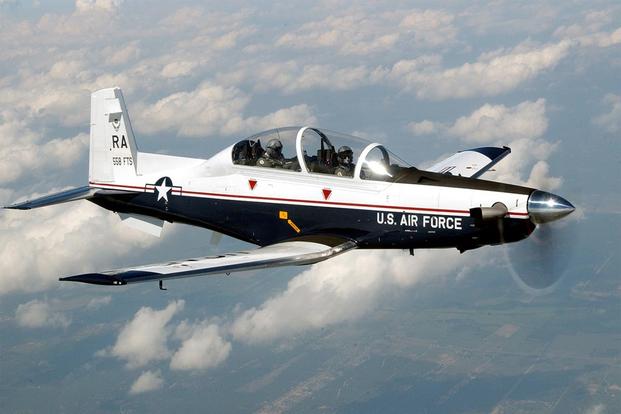The Air Force has lifted its operational pause for T-6 Texan II trainer aircraft after a number of pilots at several bases in recent weeks experienced unexplained physiological events [UPEs] while in flight.
Maj. Gen. Patrick Doherty, 19th Air Force commander, ordered the end to the pause Tuesday, with instructor pilots beginning flights first, then student pilots by the end of this week, according to a release from Air Education and Training Command.
Command officials said the cases described were not classical cases of hypoxia which is caused by oxygen deprivation. While pilots experienced similar symptoms in flight -- disorientation, shortness of breath, confusion, wheezing -- an obvious root cause has not been found.
Related content:
- Some T-6s Will Fly Next Week to Test Maintenance Technique: General
- T-6 Texan Trainers Grounded Again After Hypoxia Incidents
- Lawmakers Rip Brass for Handling of Hypoxia Incidents
"The operational pause was required to provide a robust and intrusive look at every component on every aircraft connected to or critical to the On-Board Oxygen Generating System," Doherty said in a release.
Doherty said the OBOGS received crucial examination and testing after a team of experts from the Air Force, Navy, NASA and medical crew listened to pilots, maintainers, engineers and flight surgeons across the fleet.
Their descriptions led officials to believe the T-6 "was exhibiting symptoms indicative of a compromise of the integrity of the OBOGS, leading to degradations in performance, which then likely led to the pilots' physiological events," he said.
"As tests, inspections, and data were gathered, component failures or degradations were identified as affecting the topline performance of OBOGS oxygen pressure, flow, and content, resulting in various disruptions that negatively impacted the human-machine interface," Doherty added.
But flight engineers and flight surgeons will continue to further investigate to find a final root cause, he said.
The command on Feb. 1 ordered an indefinite operational pause for all T-6 aircraft at Columbus Air Force Base, Mississippi; Vance Air Force Base, Oklahoma; and Sheppard Air Force Base, Texas.
AETC leaders on Feb. 19 began testing a new, technical maintenance order to better evaluate the system, launching 24 flights of the T-6 to experiment with the procedures.
Before pilots could take to the air, a series of evaluations took place.
"The time change technical order allows you to go through and perform maintenance on it, so the system, the first [change] is checking the valve, the second [will] check the overall system looking for leaks, how's the system's overall performance," Lt. Gen Chris Nowland, the service's deputy chief of staff for operation, told reporters after a House Armed Services Committee on Air Force readiness on Feb. 14.
Once in the air, teams in place began testing a backup method: Pilots disconnected from the OBOGS, flying at a restricted altitude.
The flights aimed to help "determine how's the system working, and what's the ambient air," or what a pilot experiences when he or she isn't connected to the system, Nowland said.
Pilots can breathe free-flowing air in the cockpit when flying under 10,000 feet, but need to hook up to an OBOGS above that altitude. If pilots experience hypoxia-like symptoms at lower altitudes, it could be an indication something else is erratic in the aircraft.
Lt. Gen. Steven Kwast, head of AETC, told Aviation Week during the Air Force Association's Air Warfare Symposium last week that investigators had not found a reason to believe pilots were getting sick from breathing ambient air, a determination that indicates something faulty in the OBOGS.
On Tuesday, Doherty said in the release that more maintenance must be taken on the OBOGS, and that the 19th Air Force would implement "recurring inspections focusing on OBOGS components."
"With 30 years of flying experience, looking at all of the facts and listening to our experts, these particular types of T-6 UPEs aren't unexplained anymore in my mind," Doherty said.
"We have zeroed in on a handful of components that are degrading or failing to perform and needed to be replaced or repaired more often than the Air Force anticipated when they bought the aircraft," he said.
-- Oriana Pawlyk can be reached at oriana.pawlyk@military.com. Follow her on Twitter at @oriana0214.












